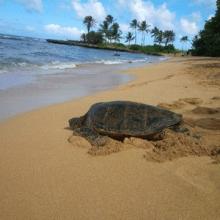WCPFC completes analysis of largest compilation to date of Pacific sea turtle-longline fishery interactions

November 2016 | Honolulu. Building on the success of the first session in February, the WCPFC-led Workshop on Joint Analysis of Sea Turtle Mitigation Effectiveness, re-convened from 3-8 November at the Western Pacific Fishery Management Council in Hawaii to complete its analysis. The workshops, which brought together representatives from 21 countries and organizations, many of which contributed confidential data for use in the workshop sessions only, was supported by the Common Oceans ABNJ Tuna Project and the Pacific Community (SPC). The goal of assessing the effectiveness of mitigation in longline fisheries was achieved by analyzing records of over 2,300 leatherback, loggerhead, olive ridley and green sea turtle interactions with longline fishery gear across the Pacific.

November 2016) © V. Caceres
Analyses focused on assessing the effects of various gear types such as hook type, bait type, soak time and depth of hooks, as well as environmental variables such as sea surface temperature and distance to land, on sea turtle interactions (hookings) and mortalities. These results were used to construct a baseline (2010-2015) of sea turtle interactions and mortalities representing the current implementation status of the WCPFC's sea turtle management measure (CMM 2008-03). The workshop then compared the baseline to a series of scenarios testing the degree to which additional mitigation would further reduce interactions and mortalities. Modelling of mitigation measures included use of large (16/0 or larger) circle hooks, finfish bait, and removal of the first, or first and second, hook positions closest to the float – the shallowest hooks – in each basket (and combinations of two or more of these measures). The scenarios also explored the effects of applying the mitigation to different sectors of the longline fishery – shallow swordfish targeting, shallow non-swordfish targeting and/or deep sectors.
The workshop conclusions were presented as proportional increases or decreases in interactions or mortalities relative to the baseline. Scenarios applying mitigation measures to deep set fisheries resulted in greater reductions in overall interactions than shallow set mitigation measures. Although interactions are more likely in shallow sets, the four-times greater amount of effort in deep set fisheries contributes to this result. Mitigation for deep set fisheries was shown to be more effective in reducing overall at-vessel mortalities than reducing overall interactions. This is a result of the fact that sea turtles caught in deep sets are more likely to asphyxiate, compared to sea turtles in shallow sets, because they cannot reach the surface to breathe. For all four species the effect of large (size 16/0 or larger, as assumed in the simulations) circle hooks in reducing interactions was greater than the effect of finfish bait. In reducing both interactions and at-vessel mortalities in deep set fisheries, mitigation involving removal of the hook position closest to the float was similar in effectiveness to changing to finfish bait, whereas removal of the two hook positions closest to the float was similar in effectiveness to changing to large circle hooks.
The results of the analyses are presented in detail in the workshop report. The report will be submitted to the WCPFC Scientific Committee in August 2017 and may be useful in revisiting the Commission's sea turtle conservation and management measure.

